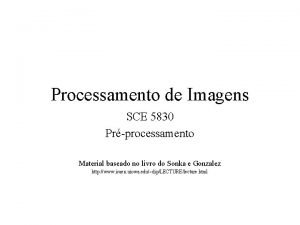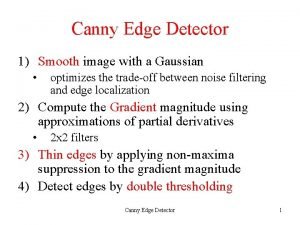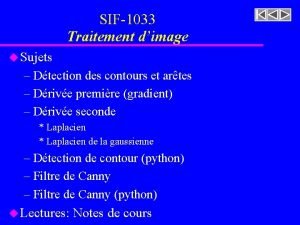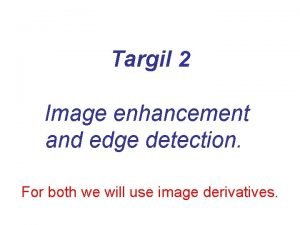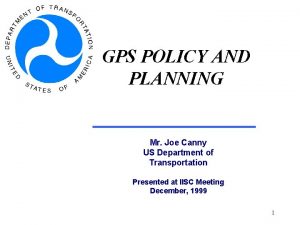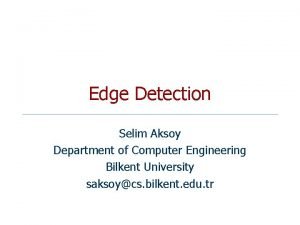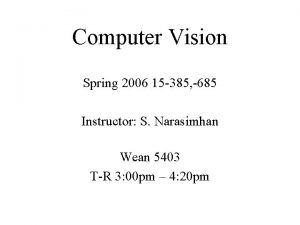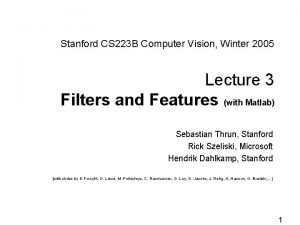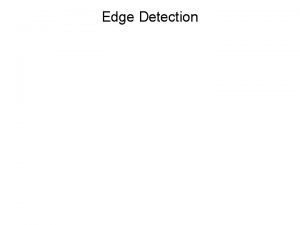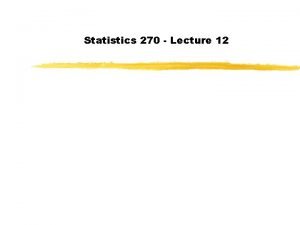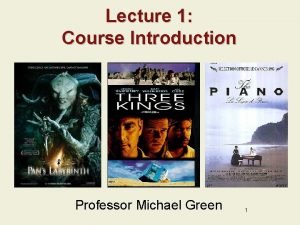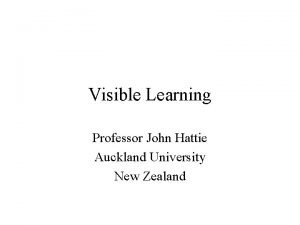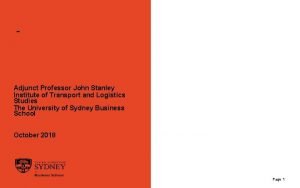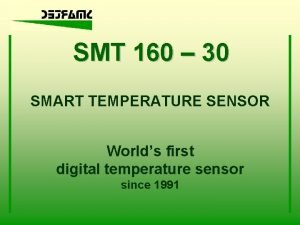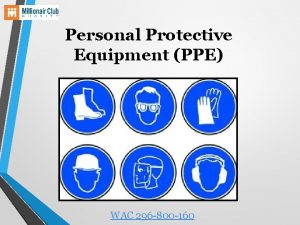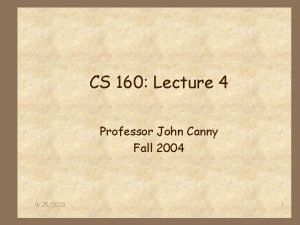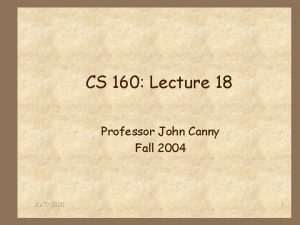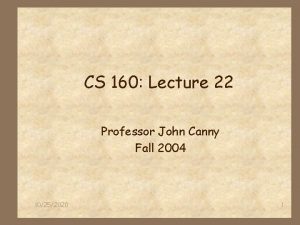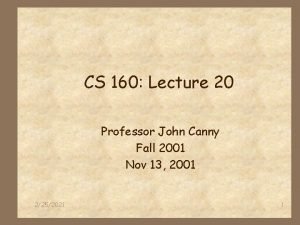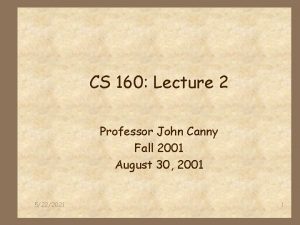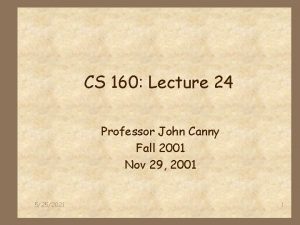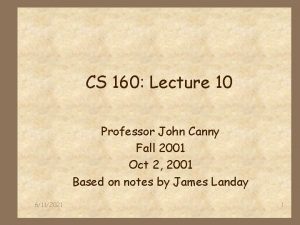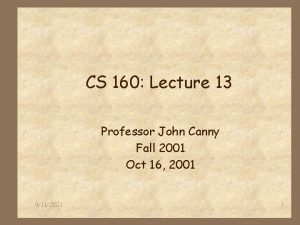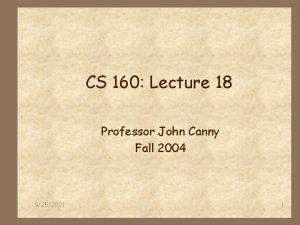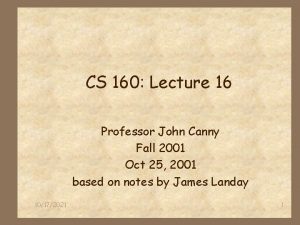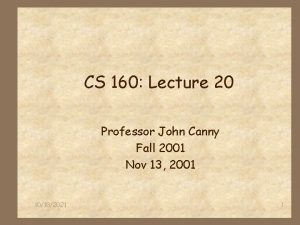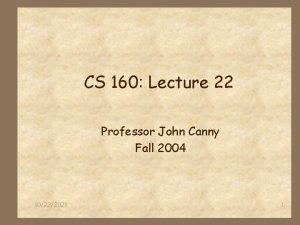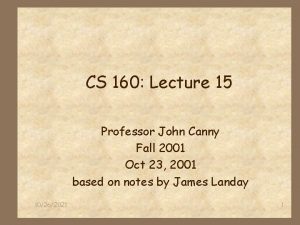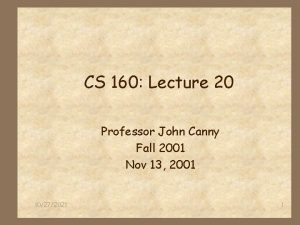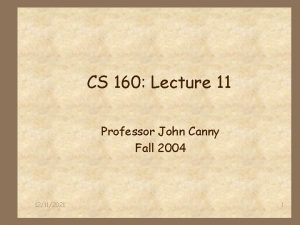CS 160 Lecture 5 Professor John Canny Fall
























- Slides: 24

CS 160: Lecture 5 Professor John Canny Fall 2001 Sept 11, 2001 5/25/2021 1

Administrivia 4 You’re in a project group now (see the web site) 4 Make sure you meet this week and come up with a project proposal. 4 Hand in the proposal by Friday 5 pm. 5/25/2021 2

Task Analysis 4 A technique for analyzing existing tasks by observation. 4 Doesn’t require understanding of Users’ goals, just what they do. 4 But because of that its harder to apply to the design of a new system. * Good for training materials and documentation 5/25/2021 3

Task Analysis: 3 Approaches 4 Tasks decomposition: looks at how a task is split into subtasks and the order in which these are performed. 4 Knowledge-based techniques: what do users need to know about the objects and actions involved in a task? How is that knowledge organized? 4 Entity-relation-based analysis: an object-based approach, identify objects, relationships and actions. 5/25/2021 4

Task Decomposition 4 Break the task into subtasks: 4 Hierarchical Task Analysis (HTA): * Organize tasks into a hierarchy * Include ordering constraints * Looks something like logic programming (PROLOG) Clean house Get vacuum cleaner Clean hall 5/25/2021 Clean rooms Clean living room Empty dustbag Put everything away Clean bedrooms 5

Task Decomposition 0. In order to clean house * Get vacuum cleaner out * Fix attachment * Clean the rooms 3. 1 Clean the hall 3. 2 Clean the living rooms 3. 3 Clean the bedrooms * Empty the dustbag * Put the vacuum cleaner away Plan 0: Do 1 -2 -3 -5 in that order Plan 3: Do any of 3. 1, 3. 2, and 3. 3 in any order depending on which rooms need cleaning 5/25/2021 6

Task Decomposition Real tasks have more structure: 4 * * * Possible ordering of steps Frequency of steps Task achievement (all or some subtasks) 5/25/2021 7

Stopping Conditions P x C rule: 4 * * P is probability of a user error on the subtask C is the cost of the error 4 When P x C is small enough, we stop expanding 4 Can also stop at “skill” steps, where the users actions are not reflective (conscious) 5/25/2021 8

Task Variations 4 Optional tasks 4 Waiting for Events 4 Cycles 4 Time-sharing 5/25/2021 9

Aside: situated action Not all activities fit the task decomposition hierarchy nicely Think about tidying a room (vs. cleaning) 4 4 * * * 4 4 See an item, put it away Look at the arrangement of things, change it The arrangement of things suggests classifications. . . Your behavior is heavily influenced by the environment So don’t forget to observe real behavior when doing task analysis 5/25/2021 10

Knowledge-based analysis 4 4 Basic idea: start with list of items, then organize into a taxonomy (often ends up being a hierarchy) e. g. driving: * Steering wheel * Seat belt * Horn control * Seats * Windscreen * Speedometer * Dashboard * Steering column * Foot pedals. . . 5/25/2021 11

Knowledge-based analysis Controls: 4 * * Steering wheel Horn control Speedometer Foot pedals… Structural 4 * * * Seats + Seat belt Dashboard + Steering column Windscreen 5/25/2021 12

Knowledge-based analysis Controls: 4 * * Steering wheel Horn control Speedometer Foot pedals… Structural 4 * * * Seats + Seat belt Dashboard + Steering column Windscreen 5/25/2021 13

Producing a taxonomy 4 4 4 Start with an exhaustive list Using existing taxonomies (e. g. parts catalog) Put the items on cards - have users arrange them Taxonomies can be captured with attribute value pairs, some required, some optional TAKD (Task Analysis for Knowledge Description) produces a Task Descriptive Hierarchy (TDH). . 5/25/2021 14

TDH 4 Conjunctives: wash/wipe AND function XOR wipe front wipers, rear wipers wash front washers, rear washers position XOR front wipers, front washers rear wipers, rear washers 5/25/2021 15

More on TDH 4 TDH can be applied to actions as well as objects. 4 In comparison with HTA (Hierarchical Task Analysis), TDH Focuses on similarity of objects 4 HTA groups objects which are related by the task 4 HTA allows arbitrary repetition, TDH encourages uniqueness. 5/25/2021 16

KRG 4 Once we have a TDH, we can describe tasks in quasi-english sentences, using the TDH terms as standard nouns and verbs. 4 Idea is to describe the task at the right level of abstraction, with unambiguous terms. 4 Sounds a lot like XML. . . 5/25/2021 17

Entity-relationship techniques Borrowed from OO databases Objects 4 4 * * * Concrete Objects Actors Composite Objects Actions 4 * * Have at least a “patient” X (action is done to X) Often an “agent” (who does the action) May involve other objects “instruments” (agent) Sam planted the leeks (patient) with his spade (instrument) 5/25/2021 18

Objects 4 * * * Concrete Objects Actors Composite Objects 4 Composite objects are collections of objects “the team”, “the kit” - sets of things 4 Composite objects may also be “tuples”, e. g. an office comprises desks, chairs, file cabinets. . . 5/25/2021 19

Actions-messages Messages are a very important kind of action because they often influence other actions 4 * * * 4 People ask people to do things People commit to doing things We acknowledge completion of actions Speech-act theory studies this 5/25/2021 20

Entities and relationships Object Sam Actions: S 1: drive tractor S 2: dig carrots Relations: object-object location(pump 3, glasshouse) Relations: action-event before(plant seed, germinate) triggers(water seed, germinates seed) 5/25/2021 21

Sources of information 4 4 4 Existing documentation Observation in a worked example Interviews (create specific scenarios) 5/25/2021 22

Uses of task analysis 4 4 4 Manuals and documentation Requirements capture for design Detailed UI design 5/25/2021 23

Summary 4 4 Find your group members! Project proposals due Friday (JFC’s office mailbox) Task analysis is a way to understand work There are 3 different ways of approaching it (which can be used together to some extent) 5/25/2021 24
 Imagem de uma rampa fonte max pixel
Imagem de uma rampa fonte max pixel What is canny edge detection in image processing
What is canny edge detection in image processing Filtre laplacien
Filtre laplacien Targil seasoning
Targil seasoning Joe canny
Joe canny Canny
Canny Canny
Canny Canny sebastian
Canny sebastian Canny mask
Canny mask Promotion from assistant to associate professor
Promotion from assistant to associate professor A college professor never finishes his lecture
A college professor never finishes his lecture Professor green lecture 1
Professor green lecture 1 01:640:244 lecture notes - lecture 15: plat, idah, farad
01:640:244 lecture notes - lecture 15: plat, idah, farad Professor john forsythe
Professor john forsythe Professor john forsythe
Professor john forsythe Professor john wood
Professor john wood Sds john holland
Sds john holland Feedback hattie effect size
Feedback hattie effect size Professor john hughes
Professor john hughes John stanley temple
John stanley temple 40 ın 10 u kaçtır
40 ın 10 u kaçtır Digital thermal sensor
Digital thermal sensor 12vac35-105-160
12vac35-105-160 Wac 296-800-160
Wac 296-800-160 Patrick liang
Patrick liang
